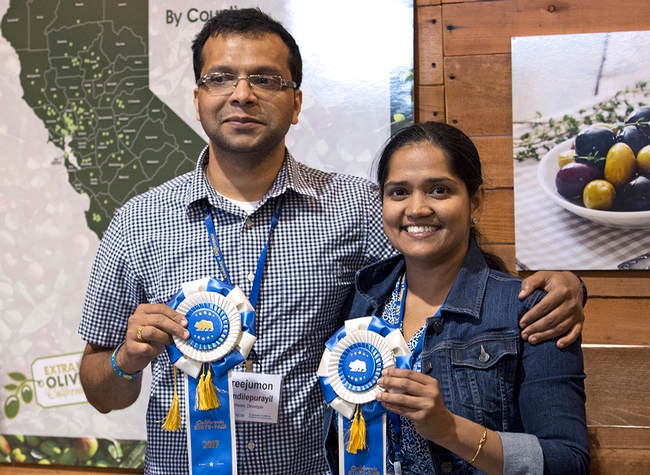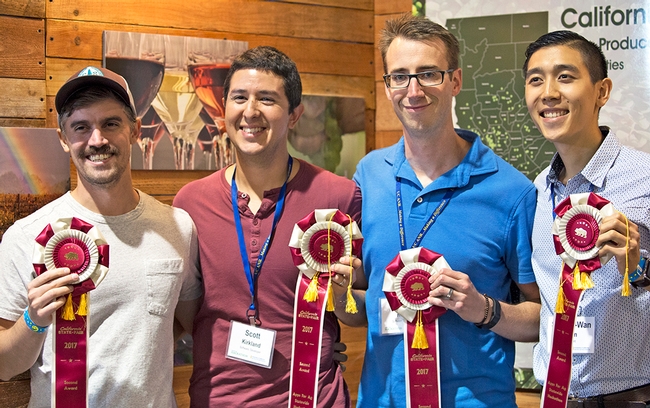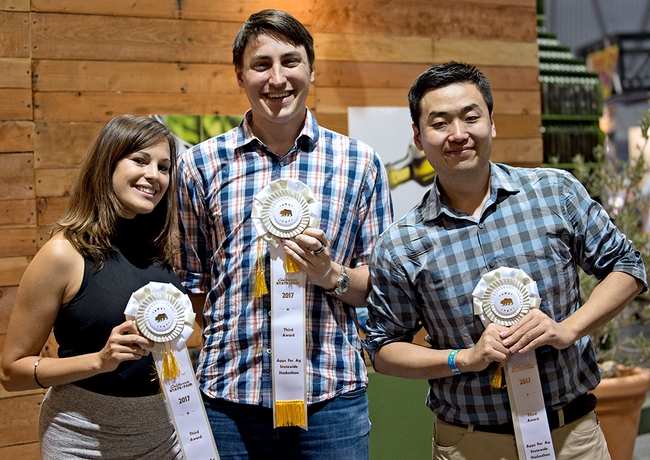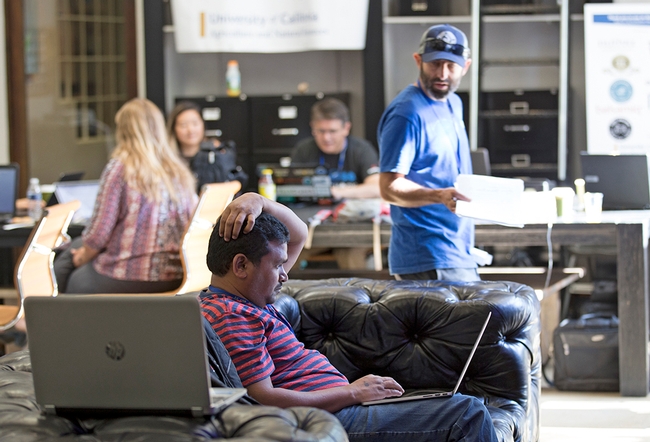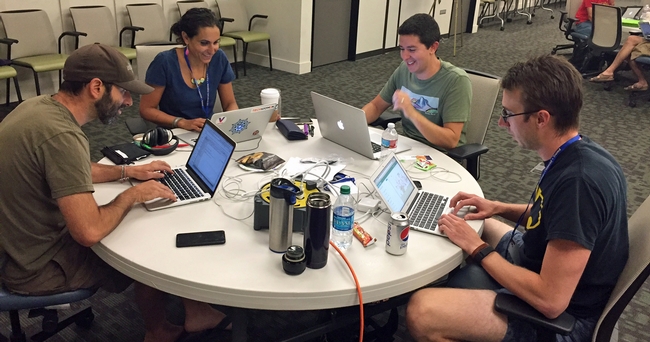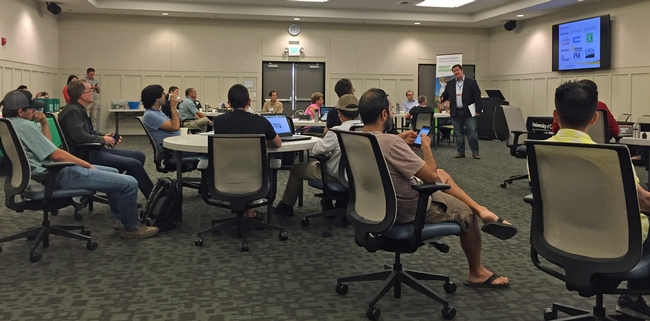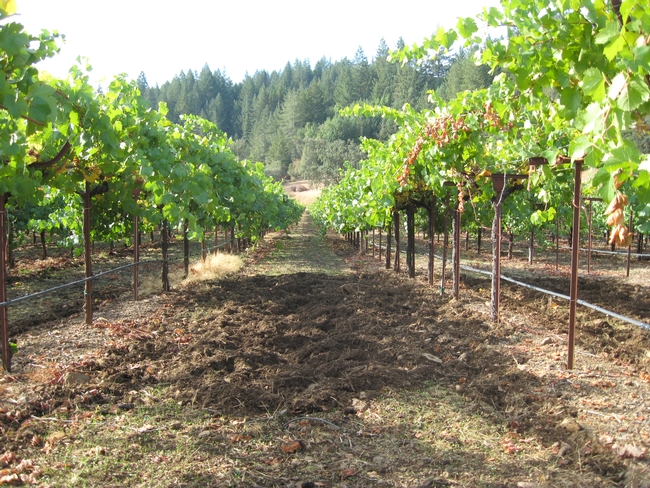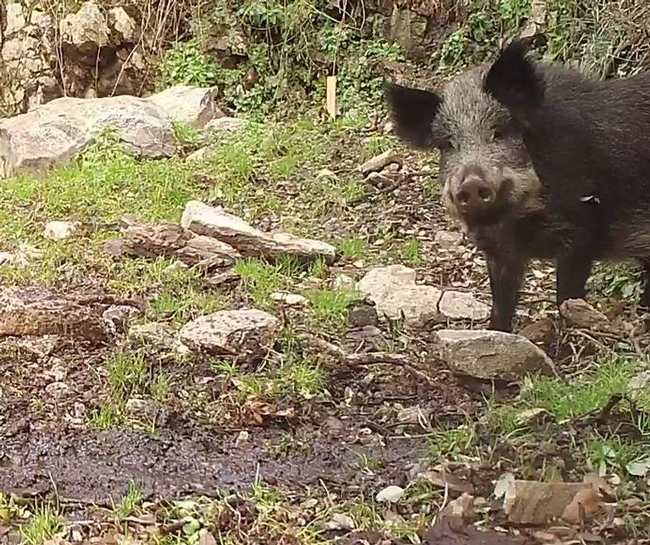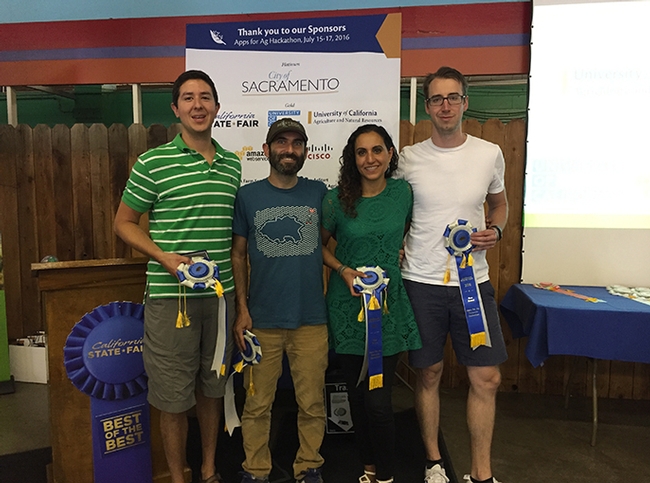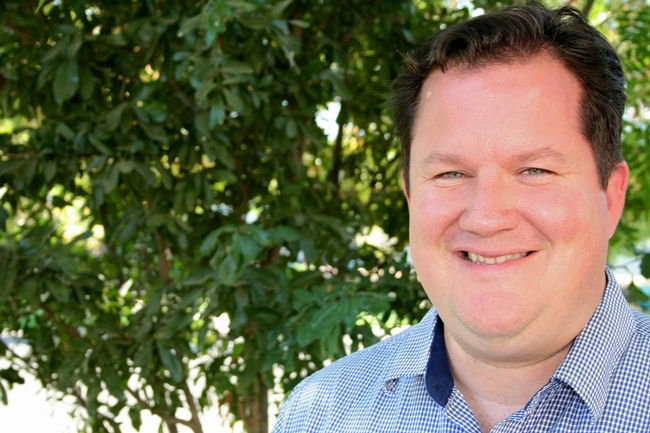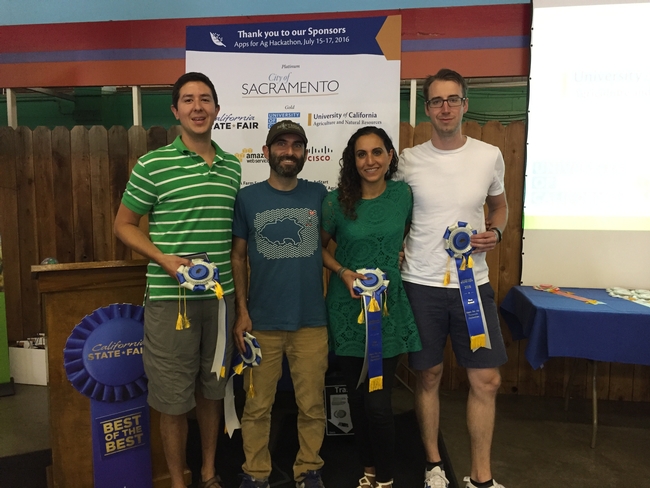Posts Tagged: Apps
Apps for Ag Hackathon winner uses artificial intelligence to diagnose plant problems
For 48 hours, innovators and entrepreneurs at the Apps for Ag Hackathon labored over laptops at The Urban Hive in Sacramento before pitching their ideas to judges at the California State Fair. More than 40 people, some from as far as New York and Texas, competed for a $10,000 grand prize and assistance from UC Agriculture and Natural Resources to turn their ideas into commercial enterprises.
Ultimately Dr. Green, a mobile app to diagnose plant problems, took the top prize on Sunday (July 30). The second-place Greener app also helps people diagnose and treat plant diseases. Farm Table, an app that promotes agritourism, came in third place.
One goal of the hackathon was to produce solutions for military veterans who are becoming farmers. The U.S. Department of Veterans Affairs was a major sponsor of the event and leaders from Washington D.C. were on site all weekend participating.
“There was an amazing range of applications this year,” said Gabriel Youtsey, chief innovation officer for University of California Agriculture and Natural Resources, which hosted the hackathon.
Twelve teams pitched new ways to apply technology to improve the food system.
“There was an application to take a picture of a plant and it'll identify the plant disease – which can help anyone from backyard gardeners to professional growers – all the way to an application for community-supported fisheries, which helps fishermen better scale their businesses and allows for customers to get the freshest fish,” Youtsey said.
There was an app to match unemployed veterans with farm jobs, an online resource for bees, an app to simplify shipping logistics, an app for detecting mold on produce and many more solutions for food-related problems.
1st Place: Dr. Green
Figuring out why a plant is ailing can be time-consuming for a new farmer or backyard gardener. The plant doctor is always in with Dr. Green. The app created by Sreejumon Kundilepurayil and Vidya Kannoly of Pleasanton will help people identify crop diseases quickly through artificial intelligence and machine learning. The app can incorporate data from sensors monitoring temperature, light and soil moisture to alert growers to problems. Using a smart phone, backyard gardeners and growers can take a photo of plant symptoms and get a diagnosis or use the messaging feature to ask a question about symptoms and receive advice immediately.
Kundilepurayil and Kannoly won $10,000 and tickets to the UC Davis Food and Ag Entrepreneurship Academy, $3,000 worth of Google Cloud Platform credits, plus other resources to help the team start their venture.
2nd Place: Greener
Using a smart phone, home gardeners can take a photo of plant symptoms and quickly get a diagnosis and recommended IPM treatment from the Greener app, created by Scott Kirkland, John Knoll and Shiang-Wan Chin of Davis and Calvin Doval of Oakland. They won $5,000 and $1,000 worth of Google Cloud Platform credits and other resources to help start their venture.
3rd Place: The Farm Table
The Farm Table app aims to make farms more economically sustainable and educate the public about food through agritourism. Heather Lee of San Francisco teamed up with Will Mitchell of Sacramento and Zhenting Zhou of New York City to create the agritourism app.
“We are making agritourism accessible to farmers by building a platform that's connecting visitors with farms,” said Lee. “This is going to help educate our communities on where their food comes from and create an additional revenue source for farmers.”
They won $2,500 and $1,000 worth of Google Cloud Platform credits and other resources to help start their venture.
Growing the pipeline of young innovators
Judges included Joshua Tuscher of the U.S. Department of Veterans Affairs; Robert Trice, investor and founder of The Mixing Bowl Hub; Jenna Rodriguez, product manager at Ceres Imaging; Ann Dunkin, chief information officer for the County of Santa Clara; and Jessica Smith, vice president of Strategic Partnerships at AngelHack.
Apps for Ag is a food and agriculture innovation event series hosted by University of California Agriculture and Natural Resources (UCANR) and sponsored by IO Labs, The Urban Hive, California Community Colleges and the California State Fair.
“We're growing the pipeline of young innovators, getting entrepreneurs and technologists interested in applying technology to solving problems in the food system,” said Youtsey, who led organization of the hackathon.
“UC ANR is the original innovation engine in food, agriculture and natural resources in California and has been so for over 100 years. This is just taking another spin at tackling innovation in food and agriculture through an innovative competition style format with technology,” he said.
Additional support for the hackathon was provided by Valley Vision, The Mixing Bowl, Farmer Veteran Coalition, AngelHack, Nutiva, Google Cloud Platform, Royse Law Firm, Hot Italian, GTS Kombucha, Startup Sac, AgStart, StartupGrind Sacramento, Future Food, Internet Society San Francisco Bay Chapter, Sacramento Food Co-op, Balsamiq and YouNoodle.
Apps for Ag Hackathon invites tech ideas to improve the food system
Winners receive $10,000 for first place, $5,000 for second place and $2,500 for third place
Food and agriculture innovators, farmers and entrepreneurs are invited to compete for $10,000 and other prizes at the 2017 Apps for Ag Hackathon July 28-30. Contestants will gather at The Urban Hive in Sacramento to create new ways to apply technology to improve the food system.
At the hackathon, anyone with an idea for technology that would simplify a task for farmers or consumers can team up with people who can turn the idea into something functional. It can be a mobile app, device or a machine.
“Apps for Ag is not just about technology and agriculture, it's about bringing together uncommon collaborators from all kinds of backgrounds and organizations to solve problems and create innovation that transform our food supply and the system behind it,” said Gabriel Youtsey, chief information officer for University of California Agriculture and Natural Resources, which is hosting the hackathon.
“We're incredibly excited to be working with The Urban Hive to host the event and to collaborate with those in the burgeoning tech and innovation scene in the Sacramento area,” said Youtsey. “Food and agriculture are natural focus areas for innovators and entrepreneurs in our region and we hope to help foster more of that growth.”
To inspire the innovators as they develop their food and agriculture ideas and technology, a few speakers will kick off the hackathon with their perspectives.
Last year's Apps for Ag winner Deema Tamimi, CEO and founder of Giving Garden, will talk about challenges facing the food system. A veteran farmer will discuss the hurdles farmers face today and the potential for technology to meet their needs. Joyce Hunter, former deputy CIO at the USDA will give a brief talk about the power of open data and how it can be used to solve some of our greatest agricultural and food challenges.
Following opening remarks, participants will present their ideas, form teams and begin to build their software applications and pitch decks over the next two days. Expert mentors will assist the teams and food will be provided throughout the event. On Sunday, July 30, at 4 p.m. the teams will present their apps to a panel of judges at the California State Fair. Members of the public are welcome to attend.
Judges include Joshua Tuscher of the U.S. Department of Veterans Affairs; Robert Trice, investor and founder of The Mixing Bowl Hub; Jenna Rodriguez Product Manager at Ceres Imaging, Ann Dunkin, CIO of County of Santa Clara, California; Nicole Rogers, director of marketing and communications for Nugget Market; and Jessica Smith, vice president of Strategic Partnerships at AngelHack.
The three top teams will be awarded cash prizes and resources to help turn their technology into a business. The winning team will receive $10,000, second place gets $5,000 and third place gets $2,500.
The Apps for Ag Hackathon will be held at The Urban Hive in Sacramento. Register for free at http://www.apps-for-ag.com.
To learn more about the hackathon, visit http://apps-for-ag.com/hackathon or email questions to info@apps-for-ag.com.
Apps for Ag is a food and agriculture innovation event series hosted by University of California Agriculture and Natural Resources (UCANR) and sponsored by IO Labs, The Urban Hive, California Community Colleges and the California State Fair.
Support for the hackathon is also provided by Sacramento and Davis community businesses and organizations: Valley Vision, The Mixing Bowl, Farmer Veteran Coalition, AngelHack, Nutiva, Google Cloud Platform, Royse Law Firm, Hot Italian, GTS Kombucha, Startup Sac, AgStart, StartupGrind Sacramento, Future Food, Internet Society San Francisco Bay Chapter, Sacramento Food Co-op, Balsamiq and YouNoodle.
The Apps for Ag series will soon become a part of The Verde Innovation Network for Entrepreneurship (The VINE), UC ANR's statewide initiative and network for food and agriculture innovators, researchers, investors and agencies slated to launch in late 2017.
Citizen scientists can help track wild pigs with new UC mobile app
Whether you call them wild hogs, feral pigs, feral hogs, wild boars, Russian boars or Eurasian boars, by any name the hairy beasts are wrecking crews on California lands. In rangelands, forests and farms, wild pigs trample crops, prey on farm animals and rip up soil with their sharp tusks, contributing to erosion.

“Rangeland managers and farmers can enter data into the app from the field so that we can estimate the land area and economic impacts of feral pig damage over a longer time period,” said Roger Baldwin, UC Cooperative Extension wildlife specialist in the Department of Wildlife, Fish, and Conservation Biology at UC Davis.
Here's how it works. To file a report, users take photos of the wild pig damage, describe the damage and note the number of pigs seen. The app will map the acreage and geographic location. Cell service is not required at the site to collect data.
When the user is connected to wi-fi or cell service, the data and photos will be uploaded to the UC Agriculture and Natural Resources server so Baldwin and John Harper, UC Cooperative Extension livestock and natural resources advisor, can analyze the data. Users will be able to see a map of wild pig damage, but to maintain user privacy, private property and user identities are blocked from the general public.
"The goal of the app is to demarcate wild pig damage, ultimately allowing us to relate this data to habitat features present at damage sites to determine the impact that these habitat components have, both on how pigs use the landscape and where damage is most likely to occur,” Baldwin said.
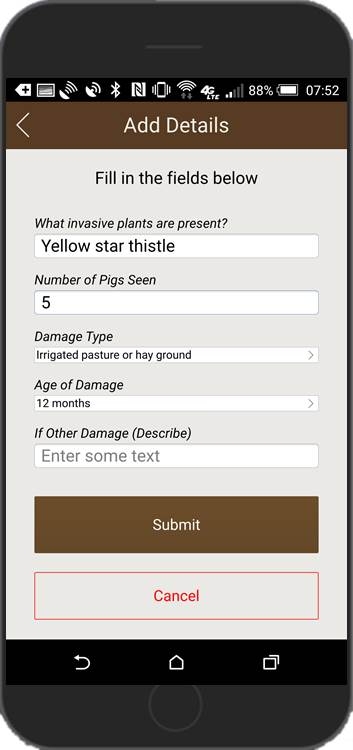
“The app, especially from a rangeland standpoint, will provide a large data set that will help us calculate acreage damaged,” said Harper, who is based in Mendocino and Lake counties. “Once that is available, we have tools, presently used for fire loss, that will allow us to calculate economic loss of forage due to the pigs. The end user would benefit in knowing that loss and policymakers would benefit from knowing the aggregate economic loss from a managed game animal.”
Wild pig populations and their associated damage are so widespread throughout California that statewide eradication efforts may not be possible, according to Baldwin.
“We probably need to focus our limited resources on managing wild pigs in targeted areas that will provide the greatest benefit,” he said. “Information collected from this app will hopefully allow us to identify these areas, ultimately resulting in more effective and practical management of wild pigs in both agricultural and natural resource landscapes."
The wild pig damage app can be downloaded for free from the App Store and Google Play. Development of the app was funded by the Renewable Resources Extension Act, a program of USDA National Institute of Food and Agriculture.
Although the study is currently focused on California, the app could be adapted to work at a regional, national or international scale. Citizen scientists can also use the app to report wild pig damage they see around the state.
To participate in the wild pig damage project without the app, landowners and ranchers can fill out a short survey at http://ucanr.edu/wildpig2016.
The survey takes about 15 minutes to complete. Individual identities and survey responses will be kept confidential and participation in the survey is entirely voluntary.
World hunger is not due to a lack of food
There is 20 percent more food available than needed to feed the whole world, reported Rachel Cernansky on FastCoexist.com. The USDA blames a data gap for the fact that some people go hungry.
Gabriel Youtsey, chief information officer for UC Agriculture and Natural Resources (UC ANR), also believes that if more data was available, consumer-facing apps, in addition to those that help farmers, researchers, industry, or government, would find it useful.
"[They] are interested in more ‘soil to shelf' transparency about how food is grown and produced and how sustainable it is," Youtsey said.
In recent years, app stores have provided an abundance of programs to connect food with people and farmers with information. One such app is "Giving Garden," which in July won the UC ANR "Apps for Ag Hackathon," held in conjunction with the California State Fair.
The hyper-local, produce-sharing app provides gardening advice from the UC Master Gardener Program and helps backyard gardeners connect with others who want to share their produce.
Giving Garden CEO Deema Tamimi said open regional-level data from USDA has been a helpful start, but the agency does not have data on specific microclimates.
"We've seen that there's a lot of people with plant species databases, but they have it under some type of license so you can't just scrape that data and use it," she said. "There's stuff out there, but it's about finding a good data set that's available, and that has no proprietary restriction on top of it."
To advance the open-data cause in agriculture, Youtsey said more public-private partnerships are needed that will help spur innovation and lead to local projects that can have more visible impacts.
"USDA data on data.gov is an excellent resource for apps, and it will be made all the richer once proprietary data stores are further opened up," he said. "It's hard for many to see the benefits of open data until hyper-local success stories start to emerge."
GivingGarden wins top prize in Apps for Ag hackathon
A gardening and produce-sharing app took top prize in the Apps for Ag hackathon, after contestants pitched judges at the California State Fair in Sacramento on Sunday (July 17). The first place team, GivingGarden, took home $7,500 in prize money, custom rodeo belt buckles and a six-month, top-tier membership to the AgStart Incubator in Woodland.
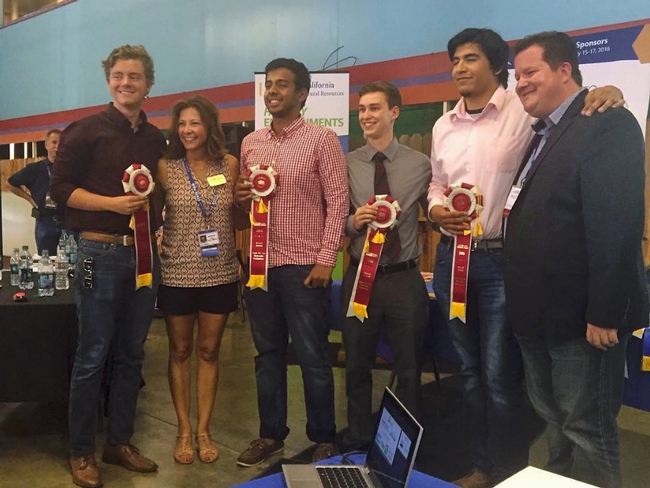
Second place was awarded to Sense and Protect, a mobile task-management app that connects to climate sensors to protect farmworkers' health and enhance their productivity. Sense and Protect team members Dhrubajyoti Das, Alex Avalos, Anthony Johnson and Peter Swanson share $4,500.
Third place went to ACP STAR System, a geo and temporal database and platform for tracking Asian citrus psyllid and other invasive pests. Team members Mark Takata and Chinh Lam share $2,500.
The top three teams will also receive complimentary startup incorporation services valued at $2,200 from Royse Law.
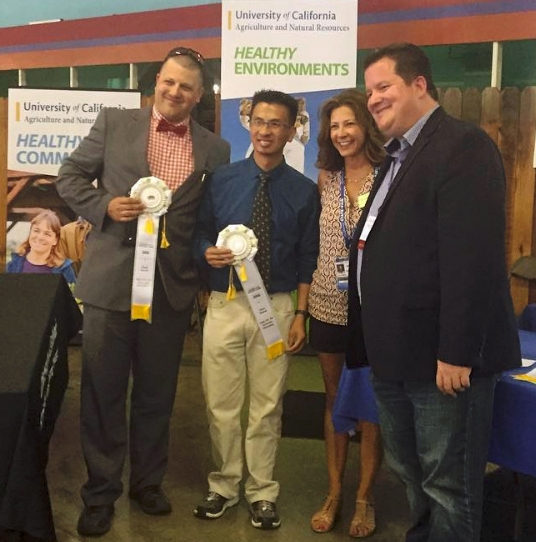
All of the participating teams had about 48 hours to develop their apps. Teams that were interested were offered $500 in “cloud credits” to build their solutions and host them on Amazon Web Services' platform. Teams also had access to an IoT kit to incorporate connected devices into their solution.
The top four teams pitched their apps to judges in front of a live audience at the California State Fair.
The Apps for Ag hackathon, which was sponsored by UC Agriculture and Natural Resources, the California State Fair and the City of Sacramento, brought together software developers, designers, entrepreneurs, farmers and others who work in agriculture.
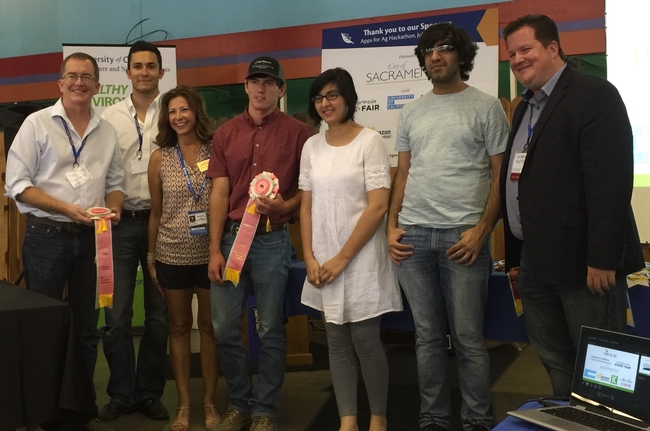
“Using technology we can find better ways to reduce pesticide use, increase irrigation efficiency, reduce travel into the fields, manage people better, and deal with the fact that we have a huge labor shortage in this state,” said Humiston, who served as one of the Apps for Ag judges.
The other judges included University of California Chief Information Officer Tom Andriola, USDA Chief Data Officer Bobby Jones, and Better Food Ventures and Mixing Bowl Hub founder Rob Trice.
For more information about Apps for Ag, visit http://www.apps-for-ag.com.
